You may have seen them on the glossy pages of lifestyle and design magazines like Dwell or House Beautiful. You’ve likely glimpsed them on your Facebook or Pinterest feed, or scrolled through photos of them on sites like Buzzfeed or Grist. And if you’ve driven though the River Arts District anytime in the last year, you’ve definitely seen them stacked up by the river.
Shipping containers seem to be the new architectural craze, and with the construction of the Smoky Park Supper Club — Asheville’s first commercial structure built from containers (19 of them, to be exact) — city residents and visitors will soon get to explore one of these buildings up close. But what is it about the look of these large steel boxes that has so captured our imagination?
“It is very trendy,” says Douglas Hecker, one of the architects who worked on the supper club. “But I think it’s also a very powerful metaphor for sustainability. It’s very much wearing your sustainability on your sleeve.”
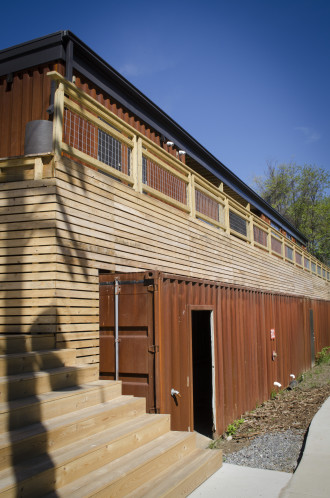
The containers that make up the structures are salvaged — one could even say rescued — from commercial freight companies where they are stored in towering stacks in port cities. Most are 8 feet wide, 8 feet tall and either 20 or 40 feet long. They are built to withstand ocean voyages — being battered by wind and water repeatedly for thousands and thousands of miles until they eventually became too old or too damaged to withstand any more commercial shipping.
“They have a life cycle just like any kind of transportation component — like trucks or trailers — so there’s a point where the containers are retired,” Hecker explains. “There’s repetitive stress from being shipped and banged around, but when a container is retired from shipping, they still exceed building code as a block for a building unit.”
That’s where the sustainability piece comes in. Turning the containers into homes, businesses or auxiliary structures saves them from being sunk into the ocean, shipped overseas empty to be melted back down to raw steel or simply left to sit in ever-increasing stacks.
“It’s an interesting concept that we’re getting to see in Asheville now,” notes Mark Matheny, plan review coordinator for the city of Asheville. “The basic principle here is that we have these containers that go across the Pacific Ocean through basically tsunamis, and then you bring them into a city and you have to figure out how to turn them into something that is safe and livable.”
Though builders and even city inspectors may be excited about the possibility of shipping container projects, the technique is still pretty new to Asheville — resulting in a lot of questions. After all, not that many people here have built with these things before.
“I’ve had people approach me and ask about turning them all kinds of angles or stacking them vertically, but this is not the way they work,” Hecker says of the bottom-heavy containers. “They want to be stacked like Legos — one on top of each other, preferably corner to corner.”
But if you’re going to think of shipping containers as grown-up Legos, think of them as Legos on steroids. Their heavy steel sides mean they can create structures that can stand the test of time and the extremes of climate. “They’re fireproof, waterproof, termite-proof — they’re very robust,” Hecker notes. “[Their lifespan] is way longer than conventional wood construction. It’s almost indefinite, really.”
Stacking up in the RAD
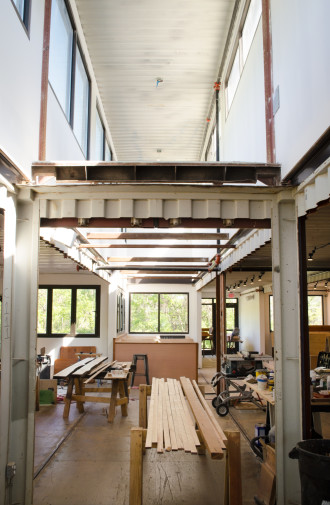
The finished look for the Smoky Park Supper Club is distinct and yet pretty congruous with the repurposed warehouses of the RAD. The structure is made from three stories of containers framed by a wooden deck that slopes down the back and leads out to the banks of the French Broad. The two containers in the third level have had their floors removed — what Hecker called the “most laborious” part of the whole process — to create an atrium in the building’s center. According to SG Blocks, the New York-based company that sourced and engineered the containers, Smoky Park Supper Club is the largest container restaurant in the country.
“The design concept was just to stack them like they would be in a container yard, just very simple and straightforward,” Hecker explains. “We also wanted the aesthetic. We wanted that association between the containers and the industrial past of the River Arts District.”
Though the vision for the restaurant’s architecture took shape quickly, Matt Logan, who owns both the restaurant and the site where it sits, says he didn’t immediately think of using containers. “I really fell in love with the property first, and then I just did a lot of research on what would work best down here,” he says. “But the containers do allow for it to be as much an art project as a building project.”
Logan adds that the whole site — which at various times has either sat neglected or held a junk-yard, a warehouse or a crack house — is a testament to the power of reusing and recycling. Before the restaurant or the neighboring buildings (including the venue called The Boathouse and the offices of Asheville GreenWorks) could be built, the site had to go through a major cleanup, aided by the U.S. Environmental Protection Agency’s brownfields program. “It’s been a complicated project,” Logan adds.
Much of the work on the containers was done off-site by SG Blocks — including using plasma torches to burn through the heavy steel to create space for the doors and windows or to remove walls or floors. The containers rolled into Asheville on 18 trucks last May, before being stacked by crane and welded to each other and to the building’s foundation.
“When we knew it was almost time for them to come, we had to label each container with a number that corresponded to our key for the design,” says Kristie Quinn, Logan’s business partner. “If you look at them now you’ll still see the numbers for each one. And that’s how they were placed. You would stop the truck and say, ‘Oh, you’ve got container No. 4?’ Because you had to make sure they were coming through in the right order.”
And while you might expect zoning and inspections to be a headache for container structures, Quinn says working with the city was a breeze. “It was a new thing for them,” she says. “But the way they approached it was to treat it like prefabrication construction. There weren’t any major obstacles. Prefab was the closest thing they could compare it to, but as time goes on, they may change that.”
A container city?
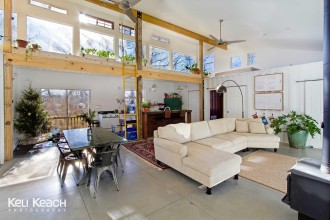
The Smoky Park Supper Club, though Asheville’s first commercial use of containers, is not its first container structure. In 2014, Brook van der Linde and Ryan Naylor moved into the West Asheville home they built DIY-style out of two containers despite “not really knowing what we were doing when we started,” Naylor says.
“It seems like in home construction right now it’s all about new, new, new — that’s the American way,” Naylor explains. “For us, the whole point of our home was to push this idea of reuse, reduce and recycle. Shipping containers are just one of the materials we used to accomplish that goal.”
The couple used salvaged windows, a shed roof and other free and low cost materials as they turned the containers into a 1,120-square-foot, three-bedroom, two bath home — chronicling each step in their journey in their blog, 40 X 28. Despite some features that “the city inspector hadn’t seen before,” Naylor says the house is “really just a regular home.”
But while a container home may pass as standard, according to Boomer Sassmann, co-founder of the Asheville Tiny House Association and a shipping container structure designer, the people attracted to these homes tend to be of the more progressive sort. “In my opinion, [containers] are a building block for folks who are thinking about building a smaller-scale home,” Sassmann says. “Those folks are already on board with the sustainability aspect, and that’s a big reason why they’re thinking about it.”
It’s the same sort of homeowner who might be interested in hemp houses or earthbag houses, Sassmann says, because container homes are just one trend capturing people’s attention. All these homes are evidence of a slowly changing mindset to conserve, to recycle and to build with less impact, he says. “Whereas in traditional construction you take all these two-by-fours and 2-by-12’s and pieces of plywood, build up to something and have all this scrap left over, with containers you flip that and say, ‘OK, start with this building block and cut pieces out,’” Sassmann notes. “It’s a totally different way of building.”
And while you certainly could build a large home from containers, Sassmann asserts that would be missing the point. “There are folks who have contacted me who say, ‘I want to build a 16-container home.’ And I say, ‘Best of luck to you.’ …. We don’t need more of those. We don’t need more 16,000-square-foot, $1 million or $2 million homes.”
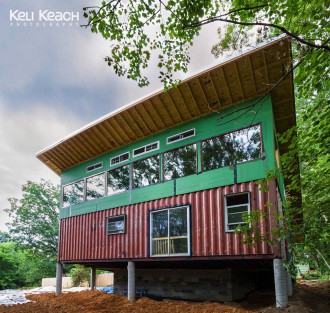
So should we expect that many more Ashevilleans will quickly follow in Naylor and van der Linde’s footsteps? Hecker says, probably not.
“As a residential trend, I am very suspicious of containers,” Hecker explains. “It takes a special kind of client — someone who either has the resources to stick their neck out [financially] or someone who says, ‘This is the house I’ve always dreamt of, and I’m going to live in it for the rest of my life and keep it in my family.’
And why is that? Hecker says, despite the way container homes are often portrayed in posts shared on social media, they’re not actually that cheap to build. “There’s a mythology out there,” he says. “I think we’ve all seen the Buzzfeed [article] that says, ‘Build a home for $2,500.’ But that’s simply not the reality.”
For one thing, container construction requires more skilled labor, specifically, “bolting and a lot of welding. And cutting through some very seriously heavy-gauge steel,” he notes. And while Hecker says that some of that cost can be reduced by doing more of your own labor, Matheny points out that another expense of a container home is that it requires working with building professionals, unlike traditional construction where you could, in theory, follow the state’s residential building codes and pass inspection.
“The residential code is pretty prescriptive — in really simply terms, it’s basically a recipe for building a house,” Matheny says. “But when we take a storage container that’s already made, nowhere in the residential code does it tell us how to turn that into a home. So that’s when you need a building professional. And that’s true for any nonprescriptive home.”
And if you’ve cleared your zoning and inspection hurdles, there’s also homeowners association codes to think of. After all, not everyone likes the look of a steel box, Sassmann points out.
And then there’s the money. Hecker adds that getting a bank to finance a container home can often be a terrible obstacle. “Banks and traditional financing are a huge roadblock to innovation and construction because there’s this focus on the resale,” he says. “I do think Asheville is a place where some local banks are probably willing to do it. But the big banks, I think will be very reticent to loan money to a container home project.”
But Hecker and Sassmann both agree that all this doesn’t mean you should throw away your dream to build a container home affordably; you just have to build to a reasonable scale and be willing to get your hands dirty.
“It doesn’t become cheaper because you’re using this recycled box, but it can be cheaper because it’s a whole different style of thinking about construction,” Sassmann says. “It’s less is more. It’s more of a minimalist approach. And it’s also about recycling these containers that are sitting in port cities around the world. You do get a bragging-rights boast from it. You get to say, ‘Hey, look at what I’m doing for the environment.’ It’s cool; it’s interesting. And it lets you, no pun intended, think outside of the box.”
Thinking big
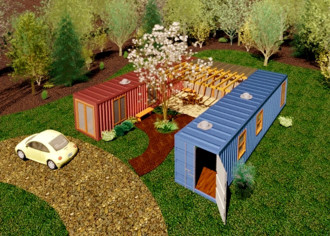
If shipping containers are compared to giant block toys for adults, it may be no surprise that the plans that have been envisioned for them — much like the varieties of Lego kits available in the toy aisle — range from the innovative to the remarkably complex to the downright fantastical.
In addition to homes and businesses, Sassmann says we might see more of them as accessory structures: workshops, storage buildings, wine cellars, root cellars and emergency bunkers. In fact, according to Sassmann, doomsday preppers were some of the first to jump on the container bandwagon. But how about, say, a houseboat? “Yeah, they’re big heavy steal boxes, but at the same time, I’m sure somebody has already taken one of these things and dropped it on top of a pontoon style setup,” he says.
How about mobile homes? Hecker says that idea has already been explored by a firm called Lot-Ek in New York, though only conceptually. “That idea of having a totally mobile, shippable home, it’s fun to think about, but it’s not practical. It would be an amazing project to realize, as it does have some of the attributes of something like an Airstream, but more like a larger home.”
But what about more altruistic uses? In 2007, Hecker, who is also a professor at Clemson University, began exploring the idea of using containers for emergency housing in developing countries in the Caribbean. When a magnitude-7.0 earthquake struck Haiti in 2010, Hecker and SG Blocks worked together on a project called SEED_Haiti. The goal was to take containers already stacked up in Haiti’s ports and turn them into housing that could withstand seismic aftershocks and provide a safer solution to the tents cities that are often used in disaster relief. For Haiti, the idea never became a reality, but it’s a concept that Hecker says is viable, though it would take “lots of work, lots of people and lots of funding.”
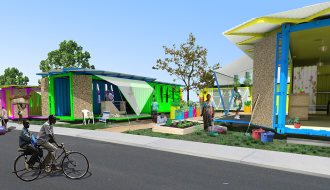
Of course, in a city like Asheville, where many residents struggle to find homes that don’t eat up over half their pay check, it’s tempting to think containers could also be a way to provide more affordable housing. Sassmann notes that a few years ago he and a partner designed a 1,400-square-foot, two-bedroom, 1 1/2 bath home that could be built for $80,000 using containers. However, “we caught a lot of criticism from people who build traditionally,” he notes. “They said, ‘Great. Whoop-de-do. We could do the same thing.’
“I think they’re right,” Sassmann continues. “You can do the same approach where you do a trimmed down, $80-$100 per square foot project with containers or with traditional wood construction, and you can hit that same price point. But if you think about it from a strength and design standpoint — which one is going to be more secure? Which one is going to be more interesting? It’s obvious that it would be the container.”
But Hecker notes that for all the imagination surrounding containers, the truth is, “Nobody wants to be known for working with brick, and no architect really wants to be known for working only with containers.” While he thinks containers are certainly useful and will continue to be incorporated into design, the novelty will eventually wear off. “At some point maybe it will just become incorporated into a choice of building materials, like brick or wood or steel are,” Hecker proposes. But, he adds, “I think they’ll be around. They make sense.”
Whatever the future holds for containers, Sassmann says, he just hopes they keep getting used. “There are so many containers in some cities around the country and around the world that the sun sets two hours earlier because it drops behind this wall of stacked-up containers, which is just crazy,” he says. “I hope whether people decide to start building homes or restaurants or bunkers or artwork or whatever it is — let’s just do it. Let’s try to reuse some of this stuff.”


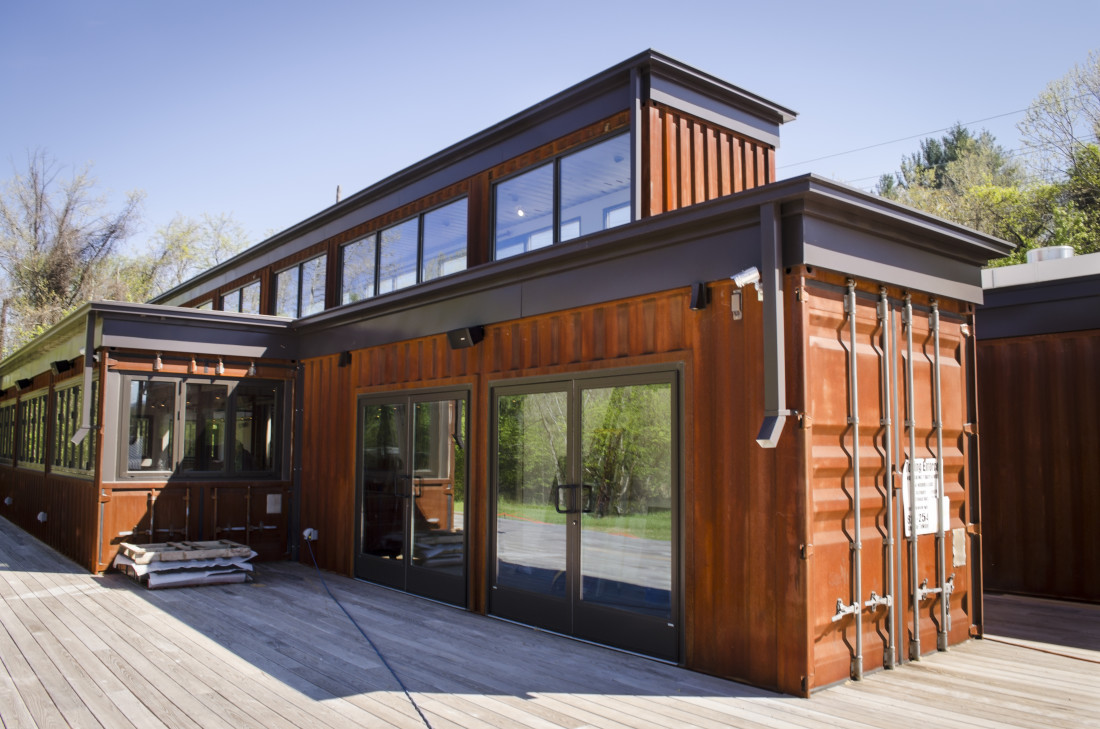
Very cool article! Thanks for sharing
Those pics with your article look like pics of The Boxcar Children’s dream homes.
The use of recycled shipping containers as a building material is a growing trend all over the world because of an abundance of the containers and shipping containers make excellent building materials because they are built to carry heavy loads and they reduce construction costs by greatly cutting the time it takes to erect a building. Building with the containers is safe, durable and sustainable. Construction is about 40 percent faster and 20 percent cheaper than traditional construction.
Than Nguyen
http://packiq.com/steel-racks
As we know the shipping container is totally steel. When you touch it in Winter, it will be very cold. Conversely, it will be very hot in summer. Besides,The decoration will cost you much. If you want to make a saving, but fear a bad insulation. Then why don’t think about prefabricated shipping container? We use the EPS sandwich panel as wall material . We can solve the heat insulation and water proof problems. You can get a similar container home with less money, why not?
If you want to know more, check this: en.yukehouse.com
How does one find contractors who are knowledgeable in shipping container buildings? Just word of mouth? I so love these homes.